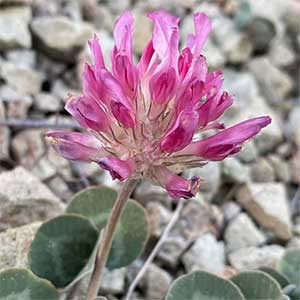Trifolium owyheense
Trifolium wormskioldii
Owyhee clover
coast clover, cow clover, cows clover, salt marsh clover, springbank clover, wormskjold's clover
cespitose, spreading, branched proximally, sparsely branched distally.
erect, ascending, or decumbent, branched.
palmate;
stipules broadly obovate, 1–2 cm, fused at base, margins slightly lobed, apex acute;
petiole 2–6 cm;
petiolules 1–1.5 mm;
leaflets 3, blades ovate, obovate, or orbiculate, slightly overlapping, 1–2 × 0.7–2.3 cm, base truncate to rounded, veins prominent, margins sparsely dentate, apex rounded, emarginate, surfaces glabrous.
palmate;
stipules ovate to lanceolate, 1.5–2 cm, margins entire (proximal stipules) or lacerate (distal stipules), apex acute to acuminate;
petiole 1–11 cm;
petiolules 0.5 mm;
leaflets 3, blades obovate to elliptic, 0.4–4.2 × 0.2–1.3 cm, base cuneate or rounded, veins fine or thickened distally, margins spinulose-serrate, apex usually acute to rounded, sometimes retuse or mucronate, surfaces glabrous.
terminal, 20–30-flowered, globose, usually formed of 2 sessile heads, 2.5–5 × 2.5–5 cm;
involucres absent.
axillary or terminal, 20–50-flowered, subglobose or globose, 1.8–2.5 × 2–2.5 cm;
involucres broadly bowl-shaped, 12–20 mm, incised 1/3–1/2 their length, lobes 10+, sharply and acutely serrate, veins prominent.
3–7 cm, surpassing subtending leaves.
1.5–11 cm.
erect, reflexed in proximalmost flowers, 1 mm;
bracteoles cuplike, 0.5 mm.
straight, 1.5–2 mm;
bracteoles linear or ovate, 1–2 mm.
15–21 mm;
calyx tubular-campanulate, 9–12 mm, pilose, veins 10, tube 4.5–6 mm, lobes subequal, abaxialmost longest, subulate, orifice open;
corolla deep pink or magenta, 20–23 mm, banner tubular for most their length, 18–22 × 5–7 mm, apex flared.
12–14 mm, odor somewhat unpleasant;
calyx whitish, tubular, 5–6 mm, glabrous, veins 10, tube 2–3 mm, lobes green to purple, subequal, abaxial rarely longer than tube, orifice open;
corolla usually magenta to purple, rarely white or bicolored, 10–12 mm, banner ovate-oblong, 12–14 × 2–3 mm, apex truncate or rounded, slightly retuse.
ellipsoid, 4–5 mm.
oblong, 2–4 mm.
1 or 2, yellow-mottled, mitten-shaped, 2–3 mm, smooth.
3 or 4, brown, sometimes mottled, subglobose or mitten-shaped, 1.5 mm, smooth.
= 16, 32.
Trifolium owyheense
Trifolium wormskioldii
Trifolium owyheense is known from about 40 populations in a small portion of east-central Malheur County in Oregon, and immediately adjacent Owyhee County in Idaho (M. Mancuso 2001).
(Discussion copyrighted by Flora of North America; reprinted with permission.)
Trifolium wormskioldii is largely tetraploid and is widespread in western North America. Distinguishing T. wormskioldii from closely allied species (especially T. mucronatum) is sometimes difficult, which led R. C. Barneby (1989) to synonymize T. mucronatum and T. pinetorum under the former name. Trifolium wormskioldii produces long, white rhizomes; T. mucronatum produces only short rhizomes at most, often only small, fibrous roots or taproots (J. M. Gillett 1980). The distinction of T. pinetorum from T. wormskioldii was supported by N. W. Ellison et al. (2006); those authors did not include material of T. mucronatum in their DNA analyses.
Trifolium wormskioldii rhizomes may have been a food resource for Native American groups in the Pacific Northwest (N. J. Turner and H. V. Kuhnlein 1982).
(Discussion copyrighted by Flora of North America; reprinted with permission.)
- Local floras:
BC,
CA,
OR,
WA
- Local Web sites:
CalFlora,
CalPhotos,
Flora NW,
PNW Herbaria,
Turner Photog.
WildflowerSearch
iNaturalist (observations)
USDA Plants Database
- LBJ Wildflower Center
- SEINet
- Plants of the World Online
- Encyclopedia of Life
- Wikipedia
- Google Image Search


